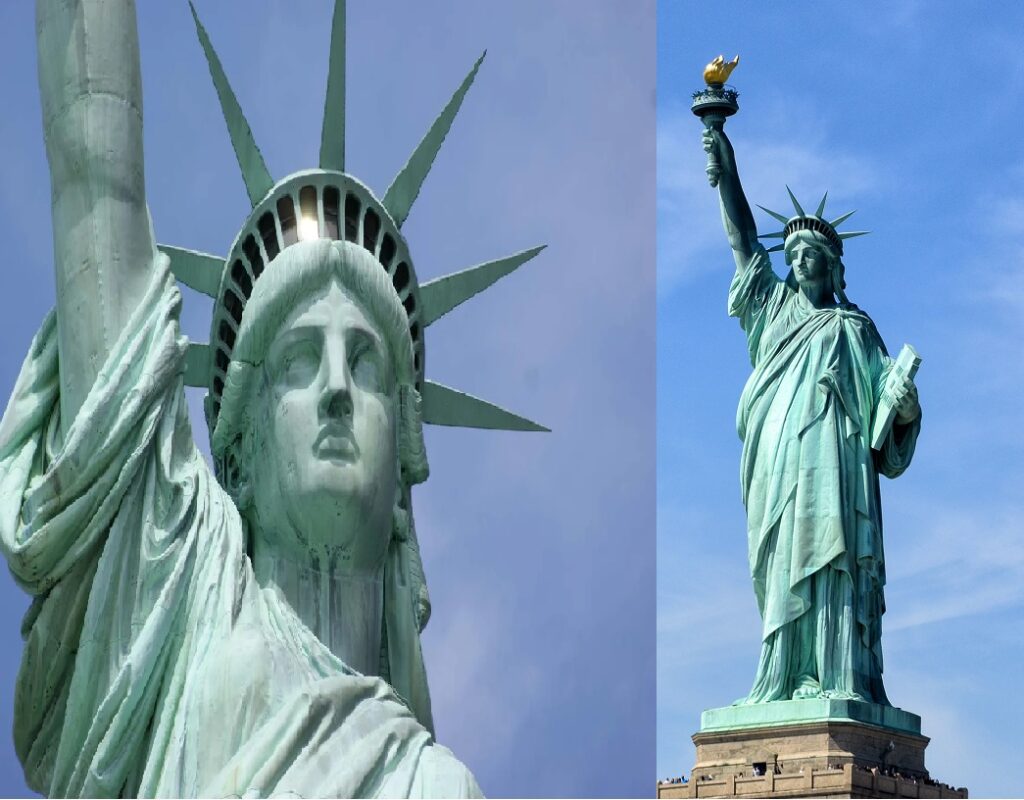The Statue of Liberty, a symbol of freedom and democracy, stands proudly on Liberty Island in New York Harbor. A gift from France to the United States, it was dedicated on October 28, 1886, and has since become one of the most iconic landmarks in the world.

Designed by French sculptor Frédéric Auguste Bartholdi, the statue is officially titled “Liberty Enlightening the World.” It depicts a woman holding a torch in her right hand and a tablet in her left hand. The torch symbolizes enlightenment and the path to freedom, while the tablet represents the law and the principles upon which the United States was founded.
The idea for the Statue of Liberty was conceived in the 1860s by Édouard René de Laboulaye, a French political thinker and abolitionist. He envisioned a monument to commemorate the centennial of the American Declaration of Independence and to celebrate the enduring friendship between France and the United States. Bartholdi was commissioned to design the statue, and the renowned engineer Alexandre Gustave Eiffel was responsible for its iron framework.
The statue was constructed in France, with the copper sheets for the exterior molded and assembled in Paris. Once completed, it was disassembled and shipped to the United States in 214 crates. The pedestal, designed by American architect Richard Morris Hunt, was constructed on Liberty Island, then known as Bedloe’s Island.
On its arrival in the United States, the Statue of Liberty was met with great fanfare and excitement. The pedestal’s dedication took place on October 28, 1886, attended by President Grover Cleveland. The statue’s official dedication took place on October 28, 1886, during a ceremony presided over by President Cleveland.
The symbolism of the Statue of Liberty was closely tied to the influx of immigrants arriving in the United States in the late 19th and early 20th centuries. Between 1892 and 1954, nearby Ellis Island served as the main entry point for over 12 million immigrants seeking a new life in America. For many of these newcomers, the sight of the Statue of Liberty as their ships approached New York Harbor was a powerful and emotional moment, representing hope, freedom, and opportunity.
Over the years, the Statue of Liberty underwent several restorations to address wear and tear from weather and environmental conditions. In the 1930s, it came under the care of the National Park Service and was designated as a National Monument. In 1984, the statue was closed to the public for an extensive restoration, which included replacing its iron armature with a stainless steel framework and refurbishing the copper skin.
Today, the Statue of Liberty remains a symbol of American ideals and values. It stands as a testament to the enduring friendship between the United States and France and serves as an inspiration for immigrants seeking a better life in America. In 1986, the statue’s centennial was celebrated with great pomp and grandeur, reaffirming its significance as a beacon of hope and freedom.
Visitors from around the world continue to flock to the Statue of Liberty, climbing its pedestal and crown for breathtaking views of New York City and the harbor. The statue’s torch, which had been closed to the public since the Black Tom explosion in 1916, was reopened in 2019 after being replaced with a new gold-leaf covered flame.
In recent years, the Statue of Liberty has also become a symbol of advocacy for human rights and social justice. It has been featured in various protest movements, art installations, and media representations, further solidifying its status as an enduring icon of freedom and inspiration.
The Statue of Liberty’s impact extends far beyond its physical presence. It stands as a universal symbol of liberty, hope, and the pursuit of a better future. It continues to serve as a reminder of the core values upon which the United States was founded and a tribute to the millions of immigrants who have sought and found refuge and opportunity in the “land of the free.”